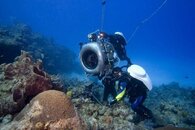smellzlikefish
Contributor
I was recently shooting blue sharks off Rhode Island with some seasoned pros (note: I am not seasoned nor a pro) who were damning the large sensors of their video setups. This flew in the face of everything I had ever learned, but they held firm. I believe their argument was that they got less depth of field with larger sensors underwater. Could someone help me understand why larger sensors may be a disadvantage?







